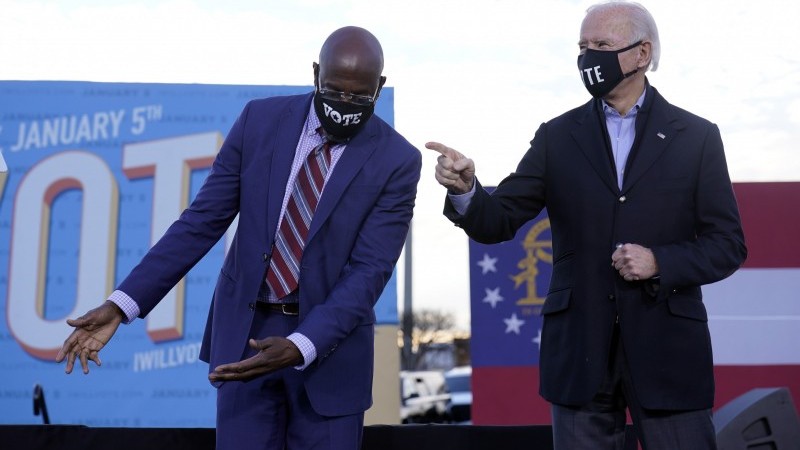Monthly US: Straining At The Leash

Democratic Senator-elect Raphael Warnock with President-elect Joe Biden in Atlanta earlier this year
The US has, so far, avoided the economic strife seen in Europe resulting from new lockdowns, but caution is warranted given evidence of the new strain having arrived. Nonetheless, as the vaccination programme gains momentum, the economy re-opens and further fiscal spending materialises, vigorous growth will return.
The short term outlook
Given rising numbers of COVID cases, we had been fearing that the 'stay at home' order in California would spread elsewhere, but so far this has not happened. Instead, individual states are largely limiting the restrictions to the cessation of dine-in eating in areas of high infections, restrictions on the size of gatherings, capacity limits in gyms, bars and some retail, and mandatory mask-wearing. This is far less onerous than what is being experienced in much of Europe.
It means we have chosen to revise higher our 4Q 2020 GDP number, but even this can’t hide a loss of momentum in the recovery. Consumer spending fell in November and we could see a further drop in December given the developments in California, the US’ most populous state. The fact that dine-in eating has ended is some major cities, including New York, forcing many businesses to close again, will also weigh on spending and jobs.
We can’t say for certain that restrictions won’t intensify. So far, only a handful of states has identified cases of the new, more infectious coronavirus strain, but if it gains a foothold and leads to an acceleration in hospitalisation rates we can well imagine 'stay at home' orders will return more broadly to the US.
This means we retain a cautious near-term outlook. We forecast only weak growth in the first quarter of 2021 despite the fact we have had a $900bn fiscal support package passed and $600 cheques are appearing in millions of people’s letterboxes.
The vaccine effect
The US is now vaccinating “at-risk” groups and the elderly, but it is going slower than planned. The goal of 20 million vaccinations by December 31st has been missed with a little over 4.5 million achieved by the first week of January while only 15 million doses have been delivered to states. This suggests there is both a failure on both the production and the distribution sides. There are also issues surrounding people who can receive it not wanting it in some states, while in Florida there reports some people are camping out overnight to make sure they get the jab.
Joe Biden is promising 100 million vaccinations in his first 100 days of the presidency (by April 30th), but with 2 shots needed and a population of 330 million, it will take time for herd immunity. Dr Anthony Fauci, who has been a key advisor to President Trump and will continue in his position within the Biden administration has raised his estimates for this from when 60-70% of the population have received the double shot to when 75-85% have received them.
One of the first acts of the Biden presidency will be to deliver the cash required to ramp up the vaccination efforts but even so, the medical establishment suggests it may not be until the third quarter that this target is achieved and “normality” could fully return.
The strength of the recovery
Nonetheless, it is the state Governor and local mayors, rather than the President, that decides what happens in the individual states, cities and towns. We can well imagine that as the vaccination rates rise through the first into the second quarter and assuming hospitalisation rates decline in response to this and the lagged effects of past containment measures, “freedoms” will return more quickly.
We expect leisure and hospitality will gradually re-open and travel more widely tolerated. With households, that in aggregate have been paying down credit cards and building up savings, able to start to spend on previously prohibited activity there will be a vigorous rebound in the service sector. This will see a rebalancing of expenditure away from “things” to “experiences” as the population makes up for lost time.
Additional momentum is likely to come from fiscal policy. President Biden is seeking to “Build Back Better”, which involves significantly increasing spending on infrastructure and green energy. The hope is that this will also deliver millions of new jobs.
The so-called "Blue Wave", which has arrived in the wake of the two Democrat Georgia senate seat victories, makes this easier to facilitate and gives us added optimism on the medium to longer-term growth outlook.
Given 2021 will see a focus on growth, we suspect promised tax hikes may be delayed until 2022/23 with tighter regulations for some industries also eased in at a later date. With the Fed assuring us of ongoing loose monetary policy and a more benign trade backdrop relative to the Trump Presidency, it looks to be a recipe for very vigorous economic activity later this year.
Disclaimer: This publication has been prepared by ING solely for information purposes irrespective of a particular user's means, financial situation or investment objectives. The information ...
more


